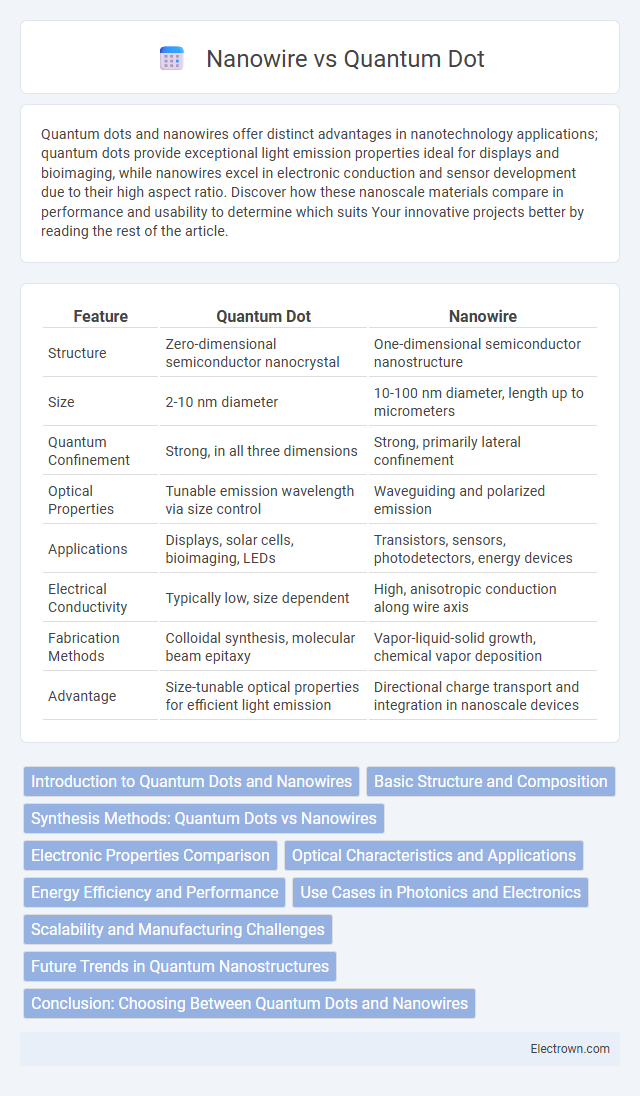Quantum dots and nanowires offer distinct advantages in nanotechnology applications; quantum dots provide exceptional light emission properties ideal for displays and bioimaging, while nanowires excel in electronic conduction and sensor development due to their high aspect ratio. Discover how these nanoscale materials compare in performance and usability to determine which suits Your innovative projects better by reading the rest of the article.
Table of Comparison
| Feature | Quantum Dot | Nanowire |
|---|---|---|
| Structure | Zero-dimensional semiconductor nanocrystal | One-dimensional semiconductor nanostructure |
| Size | 2-10 nm diameter | 10-100 nm diameter, length up to micrometers |
| Quantum Confinement | Strong, in all three dimensions | Strong, primarily lateral confinement |
| Optical Properties | Tunable emission wavelength via size control | Waveguiding and polarized emission |
| Applications | Displays, solar cells, bioimaging, LEDs | Transistors, sensors, photodetectors, energy devices |
| Electrical Conductivity | Typically low, size dependent | High, anisotropic conduction along wire axis |
| Fabrication Methods | Colloidal synthesis, molecular beam epitaxy | Vapor-liquid-solid growth, chemical vapor deposition |
| Advantage | Size-tunable optical properties for efficient light emission | Directional charge transport and integration in nanoscale devices |
Introduction to Quantum Dots and Nanowires
Quantum dots are semiconductor nanocrystals with size-dependent optical and electronic properties, often used in displays, solar cells, and biological imaging due to their tunable emission wavelengths. Nanowires are one-dimensional nanostructures with diameters typically in the range of a few nanometers, enabling efficient charge transport and enhanced surface-to-volume ratio, useful in electronics, sensors, and energy devices. Both quantum dots and nanowires play critical roles in nanotechnology, offering unique advantages for next-generation optoelectronic applications.
Basic Structure and Composition
Quantum dots are semiconductor nanoparticles typically composed of elements like cadmium selenide or lead sulfide, characterized by their zero-dimensional, spherical shape that confines electrons in all three spatial dimensions. Nanowires consist of one-dimensional, elongated structures made from materials such as silicon, gallium arsenide, or indium phosphide, allowing charge carriers to move freely along the wire's length while being confined in the other two dimensions. Understanding the basic structure and composition of quantum dots versus nanowires can help you determine the best material for applications in electronics and photonics.
Synthesis Methods: Quantum Dots vs Nanowires
Quantum dots are typically synthesized through colloidal methods involving the nucleation and growth of semiconductor nanocrystals in a solution, enabling precise size control that influences their optical properties. Nanowires are commonly fabricated using vapor-liquid-solid (VLS) growth, chemical vapor deposition (CVD), or template-assisted methods, allowing for the creation of one-dimensional structures with controlled length and diameter. The choice of synthesis method directly impacts the crystalline quality, surface states, and functional applications of both quantum dots and nanowires.
Electronic Properties Comparison
Quantum dots exhibit discrete energy levels due to quantum confinement, enhancing their electronic properties with size-tunable bandgaps ideal for optoelectronic applications. Nanowires provide continuous energy bands and high electron mobility along their longitudinal axis, making them excellent for nanoscale transistors and sensors. Your choice between quantum dots and nanowires depends on whether you prioritize quantum confinement effects or anisotropic charge transport capabilities.
Optical Characteristics and Applications
Quantum dots exhibit size-tunable optical properties with narrow emission spectra and high photoluminescence quantum yield, making them ideal for applications in display technologies, biological imaging, and solar cells. Nanowires possess anisotropic optical characteristics, enabling efficient light guiding, waveguiding, and polarization control, which are advantageous for photodetectors, nanolasers, and photonic circuits. Both nanostructures play crucial roles in advanced optoelectronic devices, with quantum dots excelling in color purity and nanowires offering directional light manipulation.
Energy Efficiency and Performance
Quantum Dots exhibit superior energy efficiency in display technologies due to their narrow emission spectra and high quantum yield, enabling vivid colors with lower power consumption. Nanowires enhance performance in photovoltaic applications by providing direct charge transport pathways, reducing recombination losses, and improving overall device efficiency. Both nanomaterials advance energy-related technologies, with Quantum Dots excelling in light emission and Nanowires optimizing charge collection and transport.
Use Cases in Photonics and Electronics
Quantum dots excel in photonics applications such as display technologies, LED lighting, and quantum computing due to their size-tunable light emission and high color purity. Nanowires are widely used in electronics and photonics for high-performance transistors, sensors, and nanoscale lasers, offering superior electron transport and integration capabilities. Your choice between quantum dots and nanowires depends on device requirements like emission wavelength control versus electrical conductivity and structural integration.
Scalability and Manufacturing Challenges
Quantum dot technology faces scalability challenges due to precise size and uniformity requirements that complicate mass production, while nanowire fabrication encounters difficulties in consistent alignment and integration at a large scale. Manufacturing quantum dots demands advanced control over chemical synthesis to achieve uniform optical properties, whereas nanowires require sophisticated growth techniques like vapor-liquid-solid methods that hinder cost-effective scalability. Your choice between these technologies should consider the balance between scalability potential and manufacturing complexity relative to your production goals.
Future Trends in Quantum Nanostructures
Future trends in quantum nanostructures emphasize the integration of quantum dots and nanowires to enhance optoelectronic devices, leveraging their size-dependent electronic properties and high surface-to-volume ratios. Advances in fabrication techniques, such as molecular beam epitaxy and chemical vapor deposition, enable precise control over quantum confinement effects, facilitating applications in quantum computing and photodetection. Enhanced tunability in emission wavelengths and increased charge carrier mobility in hybrid quantum dot-nanowire systems promise breakthroughs in energy-efficient light-emitting diodes and solar cells.
Conclusion: Choosing Between Quantum Dots and Nanowires
Quantum dots offer exceptional color purity and tunable optical properties, ideal for high-resolution displays and bioimaging applications. Nanowires provide superior electrical conductivity and mechanical flexibility, making them suitable for nanoscale electronics and sensors. Your choice depends on whether your priority is optical performance or electronic integration in advanced nanotechnology projects.
Quantum Dot vs Nanowire Infographic

 electrown.com
electrown.com